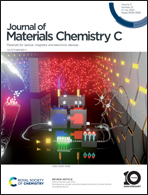Rhodamine B as an efficient multifunctional passivator for the improvement of perovskite solar cell performance†
Abstract
Organic hybrid metal halide perovskite solar cells (PSCs) have become a new class of most promising photovoltaic materials owing to high power conversion efficiency (PCE) and low-cost solution-process. Nevertheless, various defects at the surface and grain boundaries of polycrystalline perovskite films severely affect their efficiencies and stabilities. Defect passivation is one of the effective strategies for improving the photovoltaic efficiency and stability of PSCs via the decrease of non-radiative recombination losses caused by defect states. Herein, a multifunctional rhodamine B (RhB) molecule is applied for the first time for synergistically passivating defects in polycrystalline perovskite films. The carboxylic, diethyl amine and xanthene groups of RhB as Lewis bases inactivate the under-coordinated Pb2+, the π-conjugation benzene ring is able to reduce the neutral iodine related defects, and its positively charged diethyl ammonium (C![[double bond, length as m-dash]](https://www.rsc.org/images/entities/char_e001.gif) N+) and Cl− anion neutralize the charged defects, ultimately healing these trap states. After RhB passivation, the inverted PSCs based on MAPbI3 exhibit a best PCE of 20.70% with extremely low hysteresis behavior (0.06%) in comparison to the control PSCs (a PCE of 18.79% with a high hysteresis index of 1.38%). Meanwhile, the unpackaged device with RhB displays better stability owing to the hydrophobic phenyl groups of RhB hindering the decomposition of perovskite films. These results demonstrate that the synergistic passivation of multifunctional RhB in this work exhibits a novel strategy to fabricate highly stable and efficient PSCs.
N+) and Cl− anion neutralize the charged defects, ultimately healing these trap states. After RhB passivation, the inverted PSCs based on MAPbI3 exhibit a best PCE of 20.70% with extremely low hysteresis behavior (0.06%) in comparison to the control PSCs (a PCE of 18.79% with a high hysteresis index of 1.38%). Meanwhile, the unpackaged device with RhB displays better stability owing to the hydrophobic phenyl groups of RhB hindering the decomposition of perovskite films. These results demonstrate that the synergistic passivation of multifunctional RhB in this work exhibits a novel strategy to fabricate highly stable and efficient PSCs.



 Please wait while we load your content...
Please wait while we load your content...